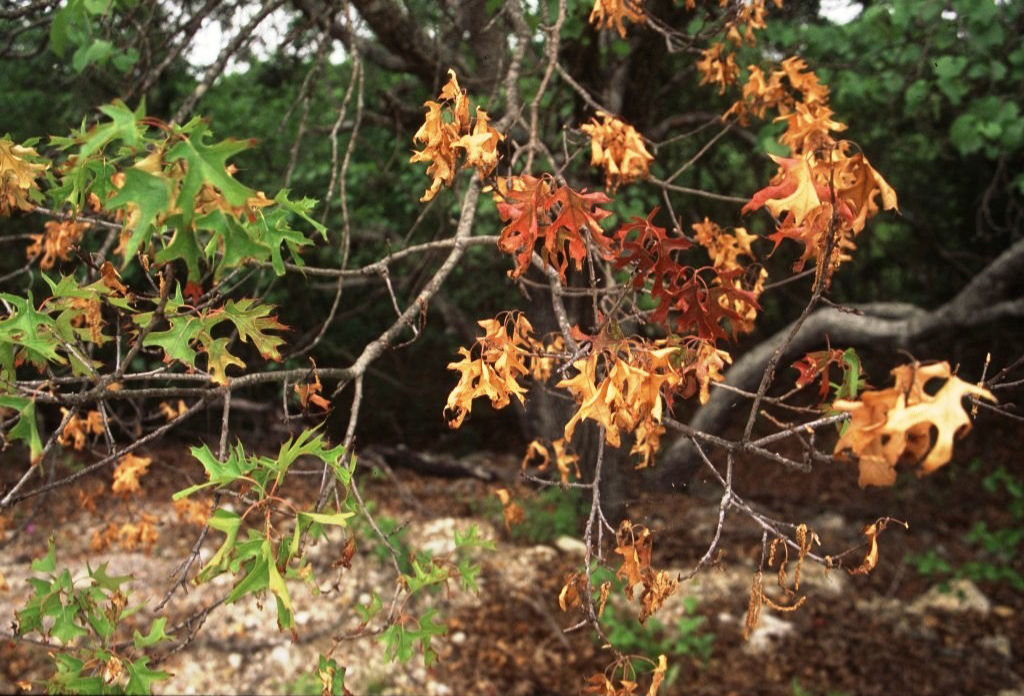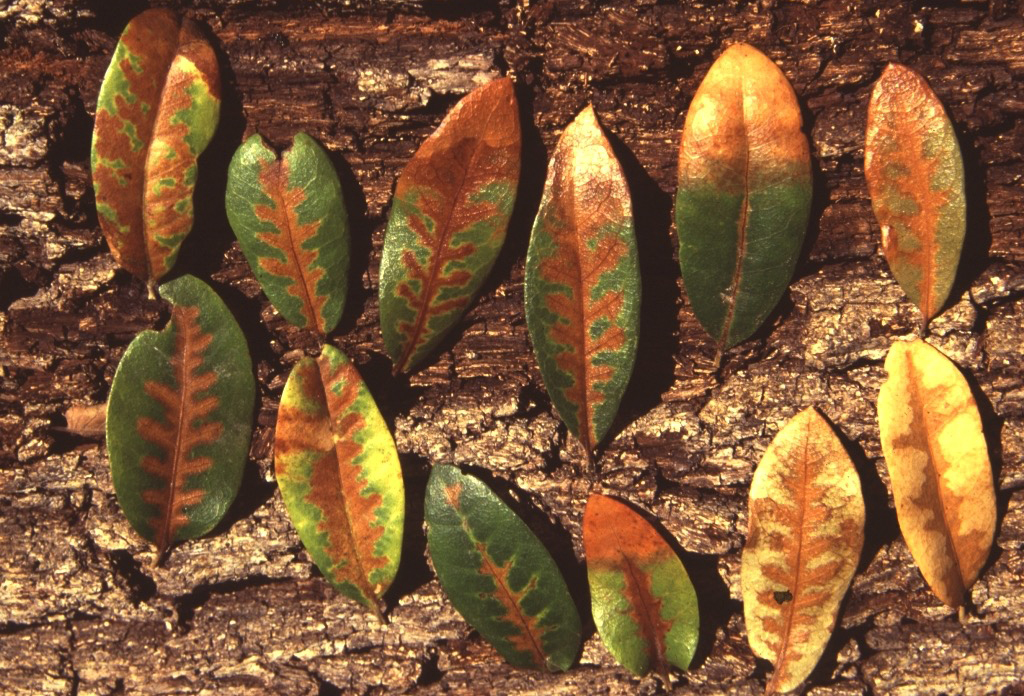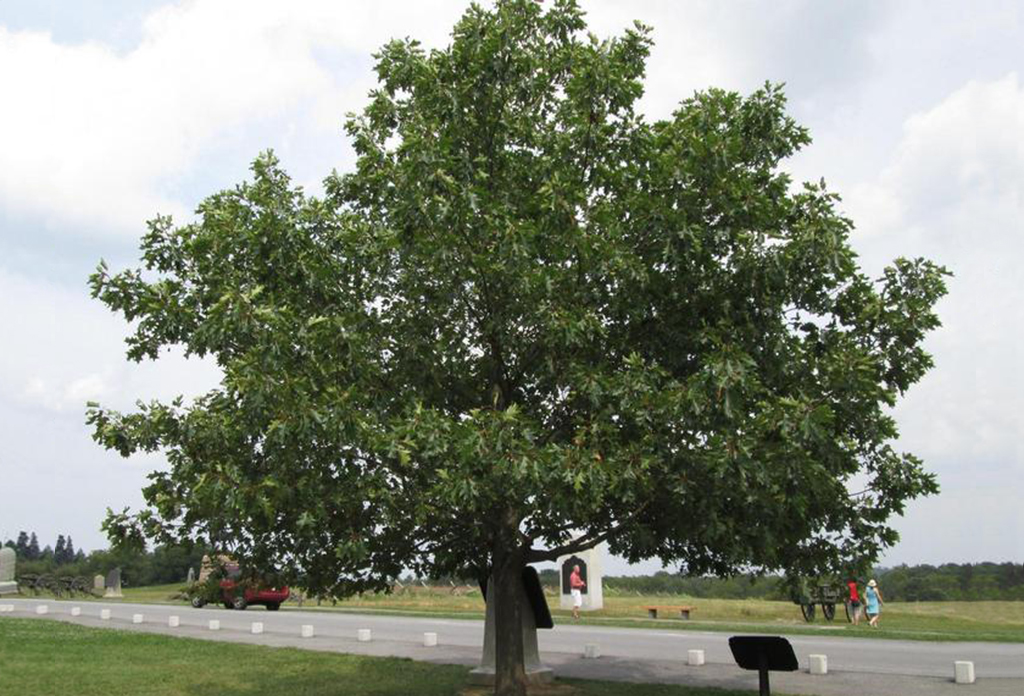Agriculture and Natural Resources Blog

Matthew Orwat
County Extension Agent – AG/NR
Email: matthew.orwat@ag.tamu.edu
Preventing Oak Wilt in Oak Trees
Article written by Master Gardener Volunteer Stephanie Suesan Smith for the Agriculture and Natural Resources division.
February 25, 2025
Oak trees can add quite a bit of value to a home. They provide shade and support all sorts of wildlife. However, oak wilt is a significant threat to oak trees in our area. Hundreds of thousands of oak trees have been killed by oak wilt. Don’t let your oak be one of them.
What is Oak Wilt?
Oak wilt is a fungal disease caused by Bretziella fagacearum. This fungus invades an oak tree by entering into a wound on the tree trunk. As the fungus grows, it plugs the vascular system and prevents water from passing through it to the canopy.
One way the fungus is spread above ground is when a beetle is attracted to a red oak with a fungal mat of spores just under the bark. As it walks on the fungal mat, it picks up spores on its feet. Later, the beetle goes to an oak tree with an open wound to eat the sap. The spores are tracked into the open wound, and they begin to grow. Beetle activity peaks in spring and early summer.
The other method of transmission is when the roots of live oaks or red oaks grow together with the roots of nearby trees. The fungus follows the roots and infects the nearby trees from them. This method is estimated to cause 90% of oak wilt infections.
How Susceptible is My Oak?
All oaks are at risk, but some oaks get oak wilt more than others. Red oaks are very susceptible to oak wilt. Live oaks have intermediate susceptibility to oak wilt. However, live oaks form vast networks of trees that are interconnected by their roots. If one tree in the network gets oak wilt, the disease will spread thorough the roots to all the trees in that group. White oaks, such as post oaks and burr oaks, are resistant to the disease.
Symptoms of Oak Wilt
The symptoms of oak wilt vary in different types of oak trees. In some, they may mimic the symptoms of other diseases. If you think your tree is infected, send a sample to the plant pathology lab for definitive diagnosis.
Red Oaks
Red oaks do not show any specific symptoms. Their leaves will turn pale green, then brown. They usually stay on the tree for a while before dropping. Mats of fungal spores form under the dried-out bark. The mats cause a crack in the bark, allowing beetles to reach them. An infected red oak dies within two to four weeks.
In Red Oaks, it is much harder to tell if Oak Wilt is present, laboratory testing is needed.
Photo Credit Texas A&M Forest
Live Oaks
Live oaks show a symptom called “veinal necrosis.” The vein down the middle of the leaf turns yellow, then brown. The leaves fall, so you should be able to find leaves with brown veins on the ground around the tree. Live oaks die within two to four months. Because live oaks often grow in clumps with interconnected roots, the oaks in the clump will begin to die in a circle around the first tree that is infected. Oak wilt can travel about 75 feet a year in this way.
The most reliable characteristic for diagnosing oak wilt in the field is what is called “veinal necrosis” of the live oak leaves. Veinal necrosis only occurs on live oak.
Photo and caption courtesy of Texas A&M Forest Service
White Oaks
White oaks show nondescript symptoms of decline. The symptoms start in the canopy, with the leaves wilting. This produces a branch with brown leaves surrounded by branches with green leaves. As the disease progresses, more and more of the tree’s leaves turn brown. White oaks may survive 3-5 years or even longer with the disease.
Red Oak
Photo courtesy of David Stephens, Bugwood.org
Treatment of Oak Wilt
There is no real effective treatment that cures oak wilt. Treatments are aimed at slowing the transmission of oak wilt through the tree’s vascular system and preventing the disease from infecting nearby oak trees. Both treatments can only be done by a trained arborist. Find one at https://isatexas.com/for-the-public/find-an-arborist/.
Trenching
Trenching cuts the roots that have grown together between oak trees to stop the spread of oak wilt. The trench has to be at least four feet deep. The recommended area to trench is 100 feet beyond the infected tree. Trees closer to the infected tree are often removed to make sure the fungal infection can’t spread. In urban areas, trenching is difficult because of the utility lines and pipes underground and the reluctance of other homeowners to sacrifice their trees.
Fungicide
If you have a high value tree live oak tree near other trees that have oak wilt, you can use the fungicide propiconazole (Alamo) as a preventative treatment. The fungicide is injected into the root flares and then repeated every 12-36 months.
Preventing Oak Wilt
Since treatments do not cure oak wilt, it is important to prevent it.
- Any wound on an oak tree should be immediately painted with tree pruning paint. This will prevent beetles from being attracted to the wound and possibly spreading oak wilt spores.
- Prune only for safety reasons between February 1 to June 31st. If a limb is going to fall and hurt someone or a building, is broken, or otherwise creating a safety hazard, go ahead and prune the tree.
- Pruning for general health and non-emergency health and safety threats should be done before February 1 or after June 31st. The best time to prune a tree for non safety reasons is in the fall.
- Immediately burn, chip, or bury diseased red oaks to break up and dry out the fungal mats on the tree.
- Clean all pruning tools before and after pruning. Use denatured methyl alcohol (shellac thinner), isopropyl alcohol, or a general-purpose household disinfectant such as Lysol, Listerine, Pine-Sol or related products. A bleach solution is not recommended because it will corrode your tools.
- Do not buy or move unseasoned firewood. Red oaks may still have fungal mats that can transmit oak wilt when freshly cut into firewood. Buy only firewood that has been seasoned for a year.
- If you have unseasoned firewood, cover the pile with clear plastic. Place stones and soil on the plastic where it meets the ground to create a seal. The sun will steam sterilize the firewood so no oak wilt spores can be transmitted. It takes a while to get the temperature up enough to work, so leave the plastic in place until you start burning the wood.
- Remove red oaks that have oak wilt or have died of it as soon as possible. Fungal mats can still transmit oak wilt the following spring if the trees are left standing. Bury, chip, or burn the removed tree.
You Can Help
By following the guidelines mentioned above, you can help prevent oak wilt. If you have any questions, you can email Matthew Orwat, the agriculture Extension agent, at matthew.orwat@ag.tamu.edu or the Dallas County Master Gardener Association Help Desk at dallasmg@ag.tamu.edu.
Find Out More
These sources have more information on oak wilt in Texas.
- Texas Oak Wilt site: http://texasoakwilt.org/
- Eight Step Program to Oak Wilt Prevention
QUICK LINKS
LOCATIONS
EMPLOYEES
-
You must be on the network to see these links.




